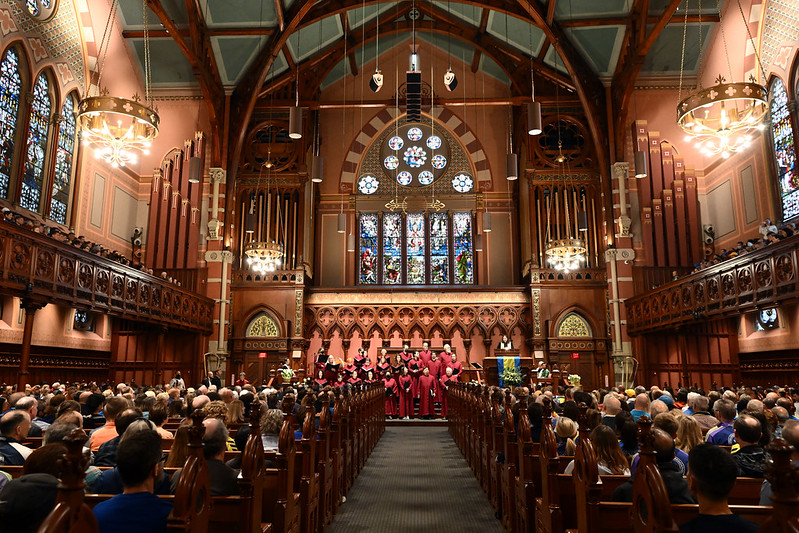Festival Worship - Fourteenth Sunday after Pentecost
Festival Worship - Fourteenth Sunday after Pentecost
The Gospel of the Old Testament
Transcript
There is a Richard Dawkins quote I love to hate; he says, ‘The God of the Old Testament is arguably the most unpleasant character in all fiction: jealous and proud of it; a petty, unjust, unforgiving control-freak; a vindictive, bloodthirsty ethnic cleanser; a misogynistic, homophobic, racist, infanticidal, genocidal, megalomaniacal, sadomasochistic, capriciously malevolent bully.’ Now, this amounts to little more than nasty, hysterical bloviating, and it is a shame that such an accomplished scientist should take the sort of hissy fits fundamentalists have to be a worthy substitute for patient reasoning. But our cultural moment is not one in which complexity of thought seems to count for much, and the guy has got to sell books somehow, so maybe we can cut him a break. Anyway, Dawkins’ words may be taunts, and he may mean to make fun of Christians, but the fact is that no small number of Christians share his sentiments. The God of the Old Testament is mean, is a brute; the God of the Old Testament is vengeful and angry and volatile; the God of the Old Testament is wrathful and punishing; the God of the Old Testament is an unhinged ogre who gets His jollies smiting kittens – this all is the stock-in-trade of church book groups and bible studies and Sunday School classes. We hardly need Richard Dawkins to tell us that the God of the Old Testament is a real jerk whose outbursts and misbehavior have tainted all of scripture up until Jesus and made reading it spiritually unprofitable. You hear this stuff from Christians all the time.
But that is not my God. And that is not the God of the Old Testament. That god is a bogeyman begotten of bad reading. To what extent it is ignorance or is deliberate distortion behind the bad reading, I do not know. What I do know is that if you add up all the verses that seem to depict God doing something morally objectionable – hurling brimstone and hellfire, zapping sinners, or whatever – you get 115. One hundred and fifteen verses. If that sounds like a lot, consider that there are over 23,100 verses total in the Old Testament; which means that our capricious tyrant of a deity loses His cool less than .5% of the time. But let’s assume I miscounted, that I tallied too conservatively; say God goes nuclear with twice the frequency as I had found to be the case. Well, double my less-than-.5% and you are still not yet sitting at a whole number. You do not have a representative sample here; you have a rounding error. Because in more than 99% of the text of the Old Testament, the cosmic meanie fails to make an appearance. I do not deny that the scattered, few instances of God acting out are difficult and troubling. But I dispute that sound interpretation can proceed from a reckoning with less than 1% of a piece of writing, a reckoning which, furthermore, pays no mind to questions of genre or historical context or ancient literary convention. Were you to read less than 1% of a work like Moby Dick or War and Peace, depending on which 1% it was, it would be entirely possible to end up not knowing that what you had read was even a novel. My point is: you should not read the Bible like somebody who is trying to flunk freshman English.
Better, I think, that our understanding of God takes shape, first and foremost, in consideration of the rest, of the 99% of the scriptures not concerned with bullying from the Great Beyond. How is the bulk of God’s time spent? What do we see? Well, if this morning’s plodding, repetitious, painfully drawn-out reading is any indication, God is rather more dedicated than you might think to… interior decorating. Six chapters – or 225 verses – of the book of Exodus are devoted to the drawing up of blueprints and designs for the tabernacle. And then another six chapters, coming in at 211 verses, describe the building, the construction work, itself. That is twelve chapters and 436 verses of God – who I want to contend may be a gay man – picking out furniture and fussing over drapery. You are more likely to find the God of the Old Testament opining about curtains than punishing sins. God is like: ‘Blue, purple, and crimson – mmhmmmmm, yes please. Puce, orange, or green? Girl, no you didn’t.’ If you add to these twelve chapters and 436 verses from Exodus the huge chunks of the books of Leviticus, Numbers, and Deuteronomy which speak to the state of purity one must be in to approach the tabernacle, that is, which spell out, Emily Post-style, the etiquette that is proper when paying God a house-call, and then add to all that prophet after prophet after prophet’s despairing of the sanctity of the later temple (which is like a tabernacle 2.0), you will see, plain as day, a portrait not of a mean God who delights in laying the smack down, but of a God who is making a home, who is making a life, who is moving in, a God who is getting comfortable, who is nesting and resting, who is settling in here, who is not off in heaven, but here on earth, here with us, who is determined to abide among us, to dwell in our midst.
The Hebrew word for tabernacle, mishkan, means simply a dwelling, a tent-home. History may have imparted to the tabernacle the aura of a holy shrine, but, at its most basic, what we are talking about is getting a roof over God’s head. The tabernacle was a den for the deity. God deigned to live in just this… lean-to. Really, this was God’s residence. Now, there was no, like, beta version of Jesus or anything, God did not become incarnate in the body of an ancient Israelite; even so, there is something incarnational happening here: the physical world hosting the spiritual, earth holding heaven within it, creation welcoming the Creator, what is immanent opening unto the transcendent. This is hard and blurs the neat modern bounds of material and immaterial, but it does seem that God’s Spirit, while not itself being physical, physically inhabited this slice of real estate. Here is how we are given to envision it: In the centermost chamber of the tabernacle was a chest – the Ark of the Covenant. Inside the chest, inside the Ark were stowed away for safekeeping the stone tablets of the Ten Commandments. A lid, then, laid on top of the Ark. And it was ornamented with statuary, with two angels, cherubim forged from pure gold, one on either side, facing each other, with their spread wings creating a kind of canopy, a crown over it all. And the space, the empty space between where the angels’ wings touched, the space, the hollow there, was called the mercy seat. And on the mercy seat, God “sat”, sort of, God brooded invisibly, in a most strange and paradoxical manner, again – as Spirit, but somehow physically present, as maybe a thickness, a heaviness, a peculiar density, a palpability, a charge in the air. God’s Being was diffuse and all around. You could not see it, but you could sense it – the goosebumps down your spine, an assurance deep, deep in your bones.
It does not take much by way of religious imagination to see in all this, the overlooked, boring stuff nobody reads, the might-as-well-be-watching-paint-dry parts people doze off during or skip over to get to the stories with all the sex appeal, to see in all this an unveiling of the very beauty of God, of who God is. Like, why go on and on and on about the poles and the rings on the side of the ark through which you put the poles? Because the tabernacle was to be portable, was to be packed up and carried off, was to follow the people from place to place. Because God wanted to go everywhere the people went. God wanted to go with them. God wanted to be with them. Because God’s presence was to accompany them through deserts and darkest valleys. Because this is who God is: the God who will be wherever you are so that you shall never be alone. Why drone on about materials and measurements, why drag out the counting of cubits? Because this all speaks to what is the most astonishingly lovely and wondrous truth and as such, which should be savored; because in these countless, seemingly uninteresting scriptures, the God of the Old Testament’s character is carefully sketched – and because what we would be given to see is a God, beguiled by love, who sacrifices, who sacrifices the comforts and perfections of Godhood to be God with us, God here with us. Because we would be given to see the great mystery of Christianity at its most embryonic: that God comes to us as we are, that we might come to be as God is. That God comes to us, actually comes to us, comes close to us, and by this closeness, comes to rub off on us – such that we cannot but be enlightened by God’s wisdom, beautified by God’s splendor, softened by God’s mercy, dignified by God’s love. Because we would be given to see what is the Gospel of the Old Testament (and of the New Testament, too): that God is truly with us, that God has come and tabernacled among us, that the Holy One has come into our midst, has come and yet comes into every moment to share life with us, and by the intimacy of this companioning, of this befriending, blesses us with know that Presence which is peace in uncertainty, joy in sorrow, strength in trial, hope in despair, life in death.







